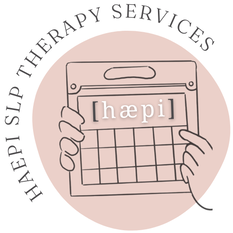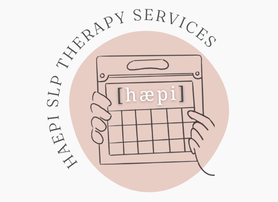|
Really inspired by everyone's vulnerability and human-ness with this trend, and I think the messaging is so important.
Social media can make us feel like everyone else "has it all together" when that is very rarely the case. These things will continue to be stigmatized (and hidden) unless we talk about it. by Halle Demchuk, SLPPaediatric SLP | GLP-Trained Clinician | Owner of HAEPI SLP
Self-advocacy is SUCH an essential communication skill for all kids, but especially for our autistic kids who likely have sensory preferences or needs. Neurodiversity-affirming goals should therefore incorporate the specific needs of the child, including sensory needs.
I know I didn't learn much (or anything...!) about creating neurodiversity-affirming goals in school, and it can seem overwhelming at first. However, when we put our kids' needs first and eliminate compliance-based therapy, it makes a lot of sense. I knew today we wouldn't get access to the school's sensory room (which is a reality, by the way! How cool is that?) so I made sure to bring materials with me that would allow for sensory breaks. This was his first time seeing this seat spinner, so I just modelled how it can be used. I even demonstrated (or tried to demonstrate) how it can be used. Maybe one day he will use it, maybe he won't, but he will learn from me that he can always ask for his needs to be met. by Halle Demchuk, SLPPaediatric SLP | GLP-Trained Clinician | Owner of HAEPI SLP
At HAEPI SLP, our goal is to provide neurodiversity-affirming speech and language therapy to all of our clients.
But what is neurodiversity affirming therapy anyways? Neurodiversity-affirming therapy involves understanding the unique obstacles that neurodivergent individuals face, and validating their experiences while celebrating their differences. At HAEPI, we celebrate the strengths a child already has (using a strength-based instead of deficit-based approach), and allow each child to be their truest, most authentic self by working within while gently expanding their comfort zones. We are committed to fostering connection OVER compliance. The ways we do this include:
So how do we do this in practice? I'll give an example from this week! One of my clients LOVES letters, and instead of "worrying" about a fixation of his interest, I used it in therapy! I hid pieces of a letter puzzle all around a playground, and he was super motivated to find them. I modelled the gestalts "let's find it," "keep looking," "I see it," got it!," "put it together," etc., in play. It was also a joint session with his OT, and because some of his OT goals included climbing on the equipment, he was motivated to do this while searching for his letters. It was also a great opportunity to discuss gestalt language strategies with his OT, and for them to see it work in practice. My therapy feels much more meaningful using these practices, and my clients show MORE speech and language progress when we focus on connection first. by Halle Demchuk, SLPPaediatric SLP | GLP-Trained Clinician | Owner of HAEPI SLP We've taken this past month to listen to Autistic and LGBTQ2S+ communities, and wanted to share some of the things we have learned. It is so important to understand that we cannot be neurodiversity-affirming without also being LGBTQ2S+ allies. We hope you celebrated this month with lots of love and pride! by Halle Demchuk, SLPPaediatric SLP | GLP-Trained Clinician | Owner of HAEPI SLP Real talk: I used to always use person-first language (e.g., person with Autism). I even had a disagreement in my grad school class with a prof who stated that identity-first was better since it made the disability "less memorable" if it was near the start of the sentence versus the end of the sentence. Cue a bunch of random research that didn't have anything to do with what each individual community preferred... Since that time, I've committed to learning and listening to Autistic voices, and something that has been expressed by the majority of Autistic individuals is the preference towards identity-first language, but not for the reason my prof said (actually quite the opposite!). Identify-first language reflects the belief that being Autistic is an inherent part of a person's identity, while person-first language reflects the belief that Autism can be separated from an individual. We know that Autism is a neurodiversity that results in a different way of seeing and interacting with the world, so it makes sense that many Autistic individuals would prefer language that is validating to their experiences and is not pathologizing. While speech-language *pathologists* do treat communication concerns, being Autistic is not - and should not be considered - one of them. by Halle Demchuk, SLPPaediatric SLP | GLP-Trained Clinician | Owner of HAEPI SLP |
The HAEPI BlogCheck here for HAEPI updates, helpful SLP information, free resources, articles, and more!
Archives
June 2024
Categories
All
|
Empowering Happy Communicators |
get in touch |
Quick Links |
© HAEPI SLP THERAPY SERVICES.
HAEPI SLP Therapy Services is proudly neurodiverse, Indigenous-owned, and woman-operated.







